- Home
- Garden Wildlife
- Insects
- Orthoptera
- Crickets
Crickets
Crickets are insects in the Orthoptera, which also includes the grasshoppers and groundhoppers. All of these insects have enlarged hindlegs that enable them to jump long distances. These two groups can be distinguished by the length of the threadlike antennae. In grasshoppers and groundhoppers, the antennae are clearly shorter than the body length. Crickets have antennae that are at least as long as the body length and often longer. Crickets are mostly pale green or greyish brown in colour and when adult are 15-50mm long, depending on the species.
Species in Britain and Ireland
There are 16 native species of cricket, but a number of others are occasional imports, some of which have become established. Some native species, like the wart biter, Decticus verrucivorus, and the field cricket, Gryllus campestris, are extremely rare and are only found in a few places. Others, like Roesel’s bush-cricket, Metrioptera roeselii, and the long-winged conehead, Conocephalus dorsalis, have increased their range in southern England since the 1980s. A non-native species known as the southern oak bush-cricket, Meconema meridionale, has become common in the London area since its discovery in 1991.
The species most frequently seen in gardens is the speckled bush-cricket, Leptophyes punctatissima, which is widespread in southern England, west Wales and south east Ireland. Pholidoptera griseoaptera, the dark bush-cricket is common in the south of England. The oak bush cricket, Meconema thalassinum, can also occur in gardens. This native species has fully developed wings when adult, unlike the non-native southern oak bush-cricket, which has its wings reduced to small flaps and is incapable of flying.
The house-cricket Acheta domesticus used to be very common in houses, but has become much less so with near universal drying central heating and general cleanliness. North African in origin, it needs warmth to survive most winters, but can be found in gardens with sheds or warm compost heaps. Jennifer Owen recorded both this and the oak bush-cricket in her Sheffield garden.
Left: Roesel's bush-cricket Metrioptera roeselii Right: House-crickets Acheta domesticus
Biology
Crickets feed mainly on foliage but some species also include other insects in their diet, particularly the oak bush cricket. The wood cricket, Nemobius sylvestris, feeds mainly on leaf litter. Their colour enable crickets to blend with the vegetation, so they often go unnoticed.
When adult, male crickets stridulate by rubbing their hind legs against the base of the forewing in order to advertise their location and attract a mate. The great green bush cricket, Tettigonia viridissima, is Britain’s largest cricket and the noisiest when stridulating. The oak bush cricket does not stridulate but makes a sound by drumming a hind leg on a leaf. The high-pitched sounds produced by most crickets can be difficult to hear, especially by older people. Bat detectors can be set to pick up the sound of stridulating crickets.
Life cycle
Female crickets have a long ovipositor or egg-laying structure which permanently protrudes from the end of the abdomen. That of female grasshoppers is largely stored internally.
Crickets generally deposit their eggs in plant stems in late summer-autumn. These eggs overwinter and hatch in late spring. The immature nymphs are smaller versions of the adult insect, with the wings and adult colour pattern gradually developing as the nymphs mature. Nymphs of the dark bush-cricket resemble spiders and presumably gain some protection from predators. They will pass through five or six nymphal stages before becoming adult in late summer. Most crickets complete their life cycle in one year but the wood cricket takes two years to become adult.
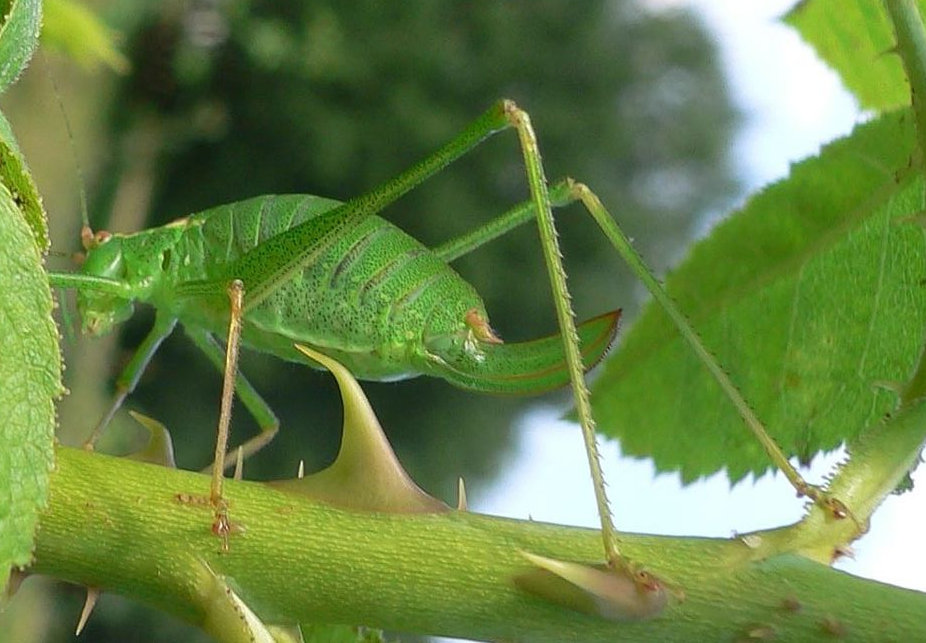
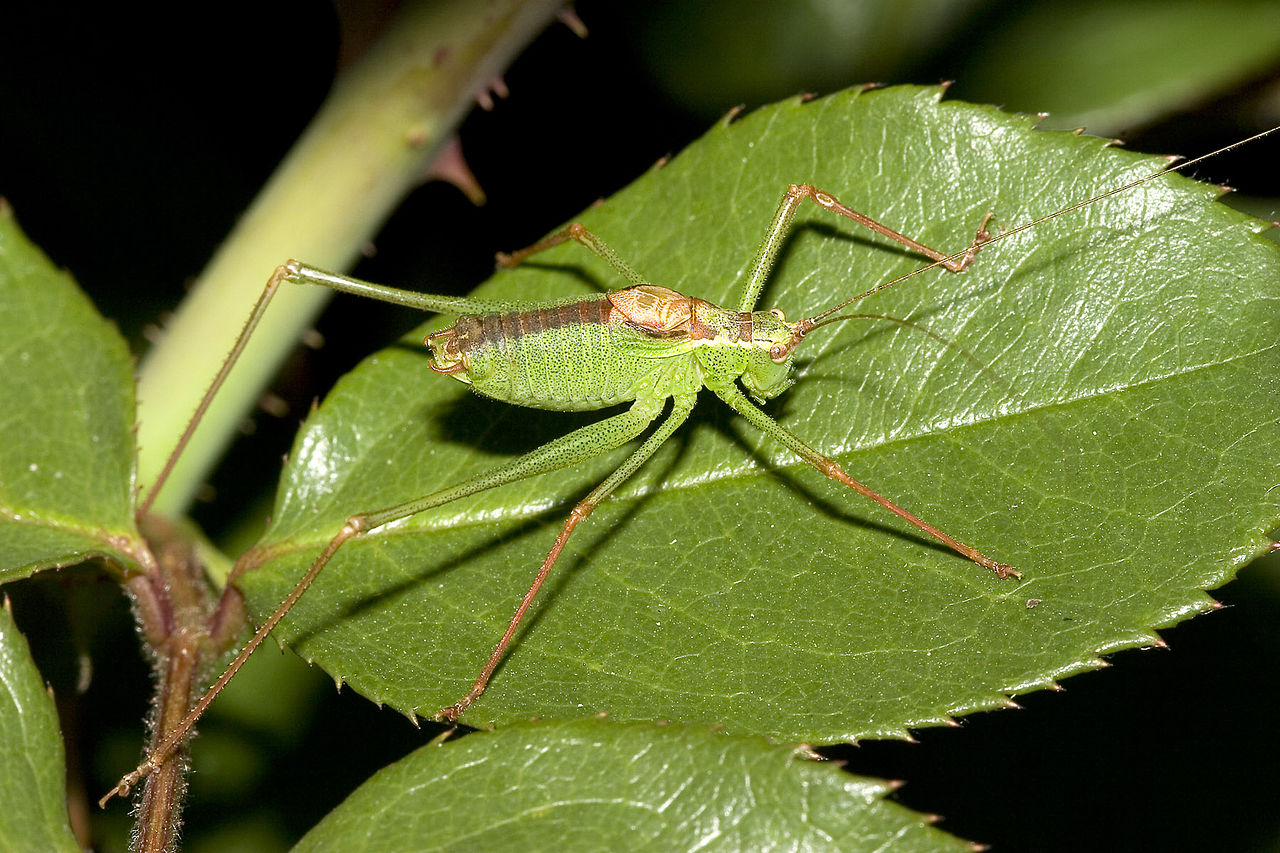
Above: Speckled bush-cricket Leptophyes punctatissima Left: female Right: male
Below: Left: Oak bush-cricket Meconema thalassinum female Right: Dark bush-cricket Pholidoptera griseoaptera female
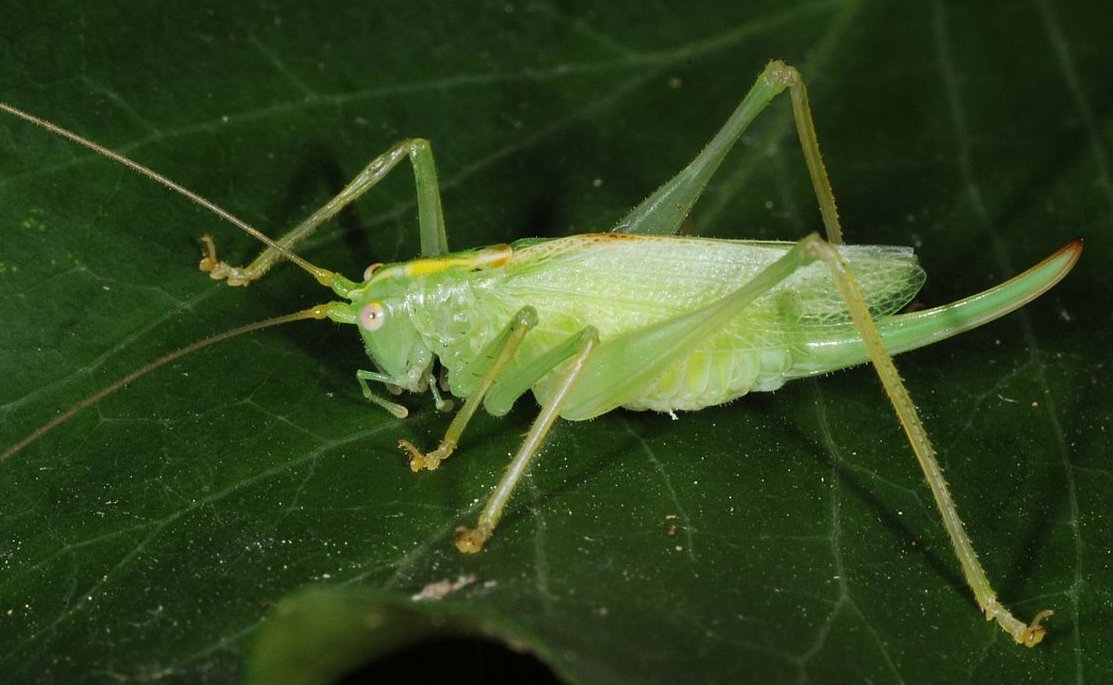
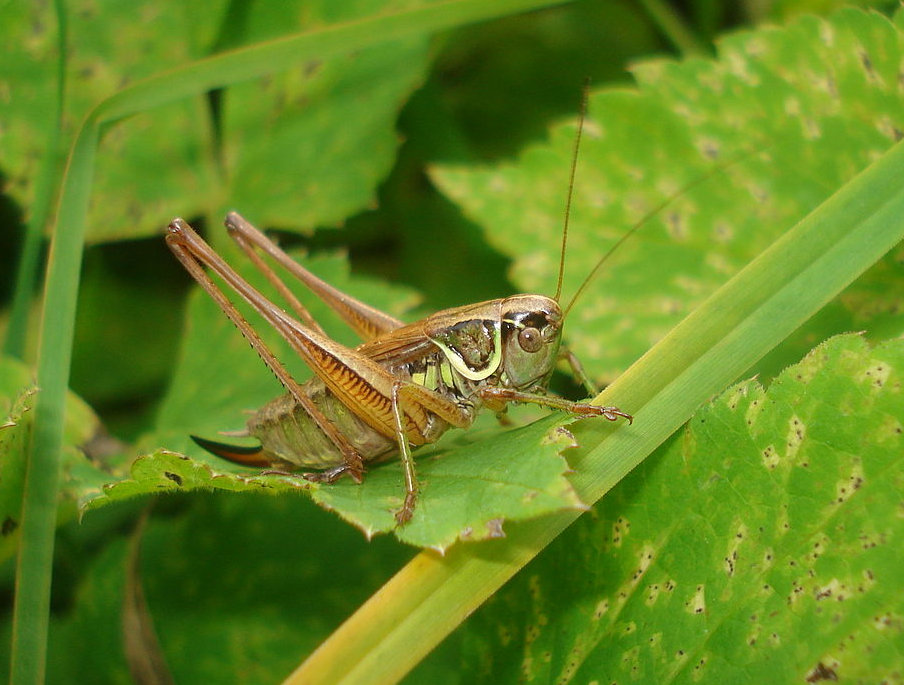
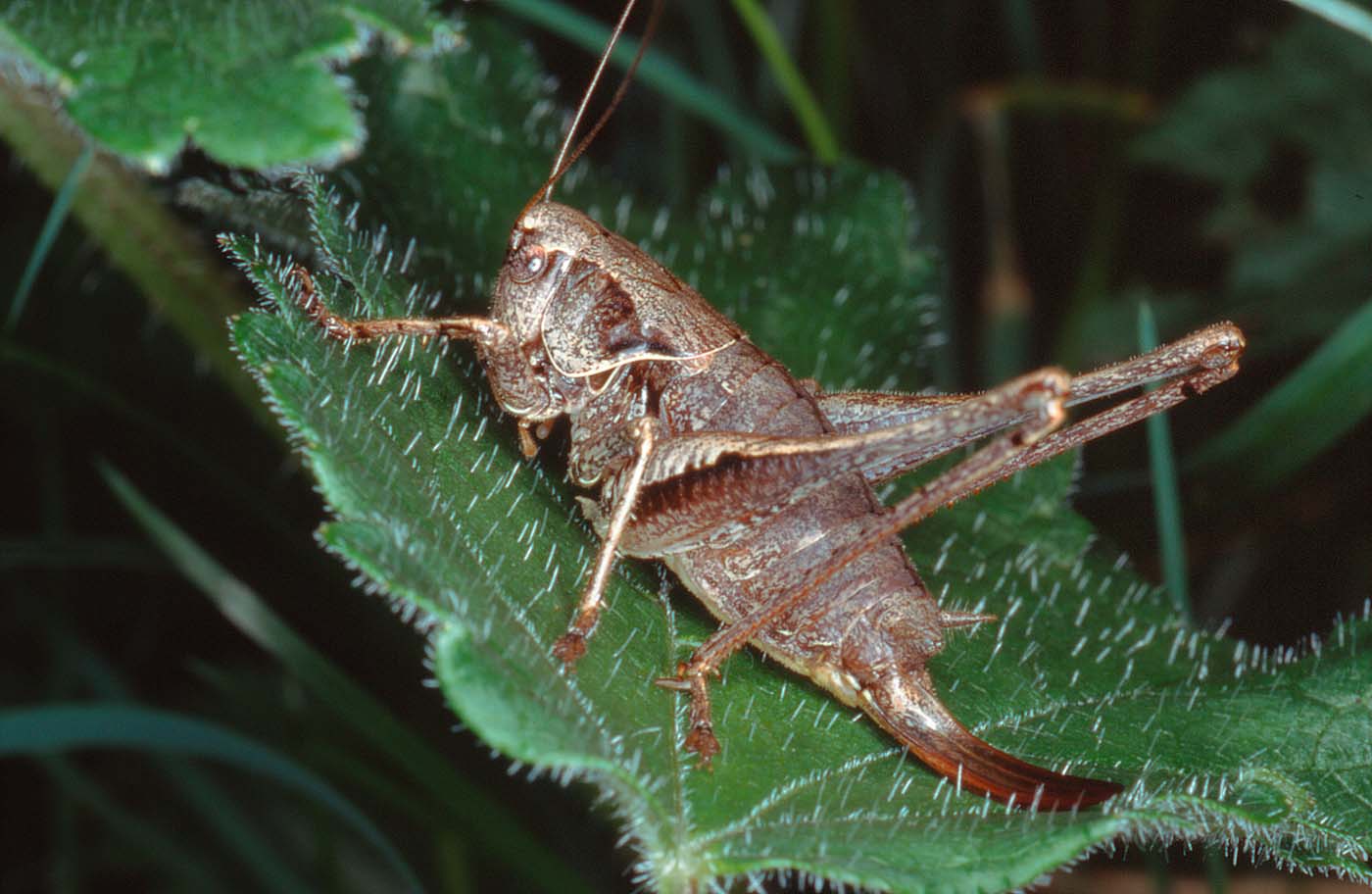
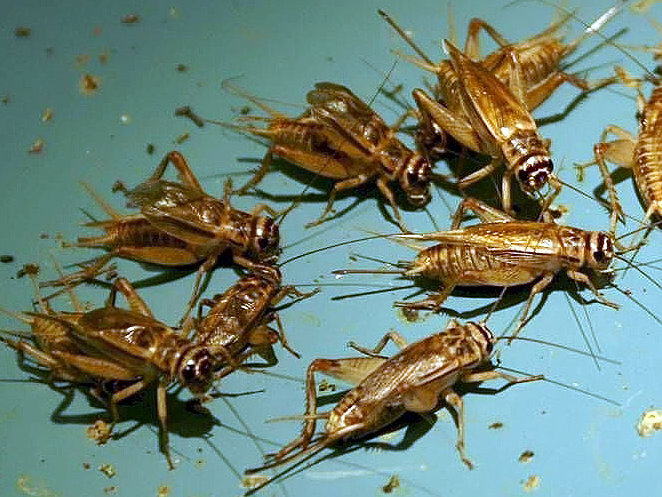
Cricket nymphs. Left Oak bush-cricket Meconema thalassinum Right: spider-mimic dark bush cricket Pholidoptera griseoaptera
Role of crickets in gardens
Although crickets will feed on foliage and flowers, they are general feeders on a wide range of plants and are rarely sufficiently abundant to cause significant damage.
Other sources of information
Website
Website of the grasshoppers and allied insects recording scheme of Britain and Ireland
Identification guide to grasshoppers and crickets of the UK
UK Orthoptera Facebook Group
Books
Benton, T. (2012) Grasshoppers and Crickets. Collins New Naturalist series no 120. Harper Collins
Brown, V. (1990) Naturalist’s Handbook 2 Grasshoppers. Richmond Publishing
Marshall, J. A. & Haes, E. C. M. (1988) Grasshoppers and allied insects of Great Britain and Ireland. Harley Books.
Page text drafted by Andrew Halstead, reviewed by Andrew Salisbury, compiled by Steve Head
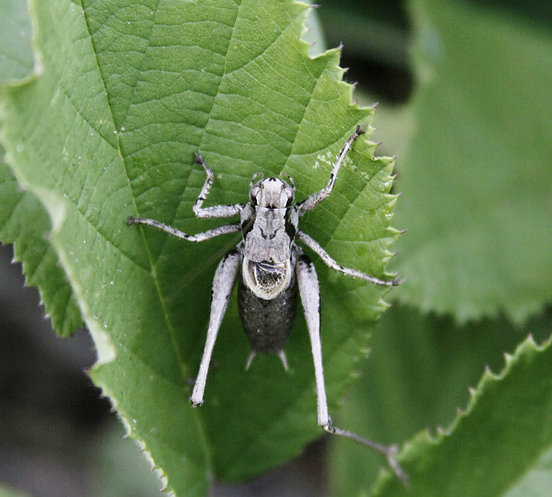
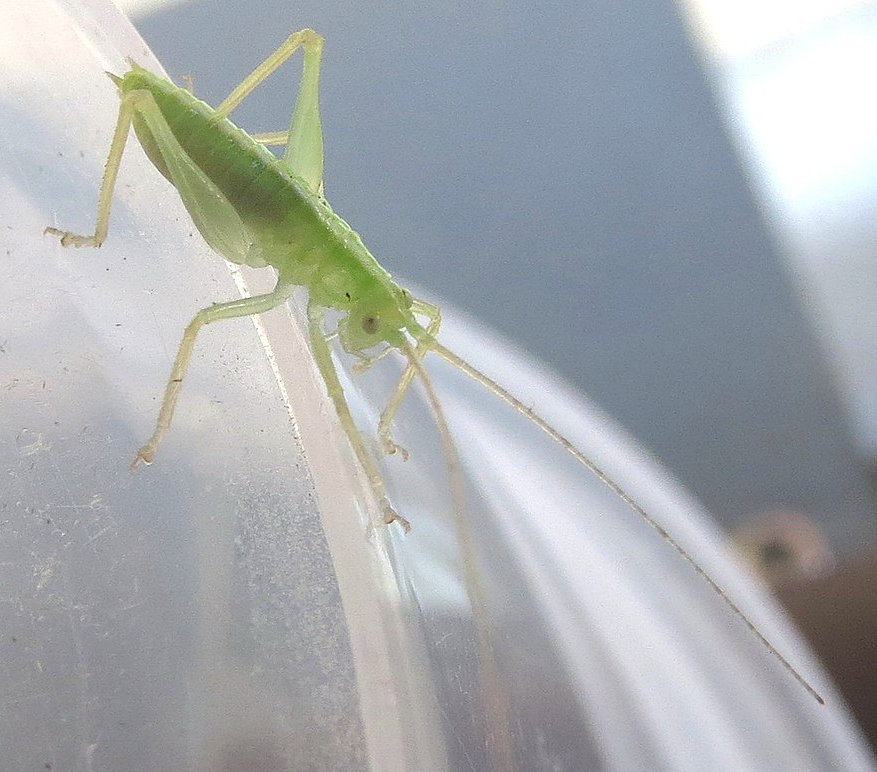
Crickets
Crickets are insects in the Orthoptera, which also includes the grasshoppers and groundhoppers. All of these insects have enlarged hindlegs that enable them to jump long distances. These two groups can be distinguished by the length of the threadlike antennae. In grasshoppers and groundhoppers, the antennae are clearly shorter than the body length. Crickets have antennae that are at least as long as the body length and often longer. Crickets are mostly pale green or greyish brown in colour and when adult are 15-50mm long, depending on the species.
Species in Britain and Ireland
There are 16 native species of cricket, but a number of others are occasional imports, some of which have become established. Some native species, like the wart biter, Decticus verrucivorus, and the field cricket, Gryllus campestris, are extremely rare and are only found in a few places. Others, like Roesel’s bush-cricket, Metrioptera roeselii, and the long-winged conehead, Conocephalus dorsalis, have increased their range in southern England since the 1980s. A non-native species known as the southern oak bush-cricket, Meconema meridionale, has become common in the London area since its discovery in 1991.
The species most frequently seen in gardens is the speckled bush-cricket, Leptophyes punctatissima, which is widespread in southern England, west Wales and south east Ireland. Pholidoptera griseoaptera, the dark bush-cricket is common in the south of England. The oak bush cricket, Meconema thalassinum, can also occur in gardens. This native species has fully developed wings when adult, unlike the non-native southern oak bush-cricket, which has its wings reduced to small flaps and is incapable of flying.
The house-cricket Acheta domesticus used to be very common in houses, but has become much less so with near universal drying central heating and general cleanliness. North African in origin, it needs warmth to survive most winters, but can be found in gardens with sheds or warm compost heaps. Jennifer Owen recorded both this and the oak bush-cricket in her Sheffield garden.


Above: Speckled bush-cricket Leptophyes punctatissima Left: female Right: male
Below: Left: Oak bush-cricket Meconema thalassinum female Right: Dark bush-cricket Pholidoptera griseoaptera female




Left: Roesel's bush-cricket Metrioptera roeseli Right: House-crickets Acheta domesticus
Biology
Crickets feed mainly on foliage but some species also include other insects in their diet, particularly the oak bush cricket. The wood cricket, Nemobius sylvestris, feeds mainly on leaf litter. Their colour enable crickets to blend with the vegetation, so they often go unnoticed.
When adult, male crickets stridulate by rubbing their hind legs against the base of the forewing in order to advertise their location and attract a mate. The great green bush cricket, Tettigonia viridissima, is Britain’s largest cricket and the noisiest when stridulating. The oak bush cricket does not stridulate but makes a sound by drumming a hind leg on a leaf. The high-pitched sounds produced by most crickets can be difficult to hear, especially by older people. Bat detectors can be set to pick up the sound of stridulating crickets.
Life cycle
Female crickets have a long ovipositor or egg-laying structure which permanently protrudes from the end of the abdomen. That of female grasshoppers is largely stored internally.
Crickets generally deposit their eggs in plant stems in late summer-autumn. These eggs overwinter and hatch in late spring. The immature nymphs are smaller versions of the adult insect, with the wings and adult colour pattern gradually developing as the nymphs mature. Nymphs of the dark bush-cricket resemble spiders and presumably gain some protection from predators. They will pass through five or six nymphal stages before becoming adult in late summer. Most crickets complete their life cycle in one year but the wood cricket takes two years to become adult.
Cricket nymphs. Left Oak bush-cricket Meconema thalassinum Right: spider-mimic dark bush cricket Pholidoptera griseoaptera
Role of crickets in gardens
Although crickets will feed on foliage and flowers, they are general feeders on a wide range of plants and are rarely sufficiently abundant to cause significant damage.
Other sources of information
Website
Website of the grasshoppers and allied insects recording scheme of Britain and Ireland
Identification guide to grasshoppers and crickets of the UK
UK Orthoptera Facebook Group
Books
Benton, T. (2012) Grasshoppers and Crickets. Collins New Naturalist series no 120. Harper Collins
Brown, V. (1990) Naturalist’s Handbook 2 Grasshoppers. Richmond Publishing
Marshall, J. A. & Haes, E. C. M. (1988) Grasshoppers and allied insects of Great Britain and Ireland. Harley Books.
Page text drafted by Andrew Halstead, reviewed by Andrew Salisbury, compiled by Steve Head














